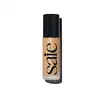What's inside
What's inside
 Key Ingredients
Key Ingredients

 Benefits
Benefits

 Concerns
Concerns

 Ingredients Side-by-side
Ingredients Side-by-side

Water
Skin ConditioningDicaprylyl Carbonate
EmollientDicaprylyl Ether
EmollientTrioctyldodecyl Citrate
EmollientGlycerin
HumectantPolyglyceryl-6 Polyricinoleate
EmulsifyingPolyglyceryl-6 Polyhydroxystearate
EmulsifyingPolyester-7
Skin ConditioningMica
Cosmetic ColorantNeopentyl Glycol Diheptanoate
EmollientSqualane
EmollientSodium Chloride
MaskingSodium Hyaluronate
HumectantPolyglutamic Acid
Skin ConditioningPhyllanthus Emblica Fruit Extract
HumectantAlthaea Officinalis Root Extract
Skin ConditioningOryza Sativa Bran Extract
Skin ConditioningMagnesium Stearate
Cosmetic ColorantGlyceryl Caprylate
EmollientTrihydroxystearin
Skin ConditioningPolyglycerin-6
HumectantTriethoxycaprylylsilane
Caprylhydroxamic Acid
Stearic Acid
CleansingTocopherol
AntioxidantAscorbyl Palmitate
AntioxidantSodium Benzoate
MaskingPotassium Sorbate
PreservativeIron Oxides
CI 77891
Cosmetic ColorantCI 77492
Cosmetic ColorantCI 77499
Cosmetic ColorantWater, Dicaprylyl Carbonate, Dicaprylyl Ether, Trioctyldodecyl Citrate, Glycerin, Polyglyceryl-6 Polyricinoleate, Polyglyceryl-6 Polyhydroxystearate, Polyester-7, Mica, Neopentyl Glycol Diheptanoate, Squalane, Sodium Chloride, Sodium Hyaluronate, Polyglutamic Acid, Phyllanthus Emblica Fruit Extract, Althaea Officinalis Root Extract, Oryza Sativa Bran Extract, Magnesium Stearate, Glyceryl Caprylate, Trihydroxystearin, Polyglycerin-6, Triethoxycaprylylsilane, Caprylhydroxamic Acid, Stearic Acid, Tocopherol, Ascorbyl Palmitate, Sodium Benzoate, Potassium Sorbate, Iron Oxides, CI 77891, CI 77492, CI 77499
Caprylic/Capric Triglyceride
MaskingOctyldodecanol
EmollientCalcium Sodium Borosilicate
Mica
Cosmetic ColorantSynthetic Fluorphlogopite
Helianthus Annuus Seed Wax
Skin ConditioningSynthetic Beeswax
Emulsion StabilisingSilica
AbrasiveTin Oxide
AbrasiveAleurites Moluccanus Seed Oil
Skin ConditioningPassiflora Edulis Seed Oil
EmollientEthylhexyl Palmitate
EmollientHelianthus Annuus Seed Oil
EmollientVictoria Amazonica Flower Extract
Skin ConditioningTrihydroxystearin
Skin ConditioningSodium Hyaluronate
HumectantGlucomannan
Skin ConditioningCI 77891
Cosmetic ColorantCI 77491
Cosmetic ColorantCI 77492
Cosmetic ColorantCI 77499
Cosmetic ColorantCI 77510
Cosmetic ColorantCI 15850
Cosmetic ColorantCaprylic/Capric Triglyceride, Octyldodecanol, Calcium Sodium Borosilicate, Mica, Synthetic Fluorphlogopite, Helianthus Annuus Seed Wax, Synthetic Beeswax, Silica, Tin Oxide, Aleurites Moluccanus Seed Oil, Passiflora Edulis Seed Oil, Ethylhexyl Palmitate, Helianthus Annuus Seed Oil, Victoria Amazonica Flower Extract, Trihydroxystearin, Sodium Hyaluronate, Glucomannan, CI 77891, CI 77491, CI 77492, CI 77499, CI 77510, CI 15850
 Reviews
Reviews

Ingredients Explained
These ingredients are found in both products.
Ingredients higher up in an ingredient list are typically present in a larger amount.
Ci 77492 is also hydrated iron III oxide. It's sole purpose is to give a yellow hue to products.
Iron III oxides are classified as inorganic chemicals for coloring.
Synthetically created Ci 77492 is considered safer than those naturally found. This is because the synthetically created version may contain less impurities. Iron oxides are generally non-toxic and non-allergenic.
Learn more about CI 77492Ci 77499 is also hydrated iron III oxide. It is created from mixing red and black iron oxides. This helps give shades of darkness to a product.
Iron III oxides are classified as inorganic chemicals for coloring.
Ci 77891 is a white pigment from Titanium dioxide. It is naturally found in minerals such as rutile and ilmenite.
It's main function is to add a white color to cosmetics. It can also be mixed with other colors to create different shades.
Ci 77891 is commonly found in sunscreens due to its ability to block UV rays.
Learn more about CI 77891Mica is a naturally occurring mineral used to add shimmer and color in cosmetics. It can also help improve the texture of a product or give it an opaque, white/silver color.
Serecite is the name for very fine but ragged grains of mica.
This ingredient is often coated with metal oxides like titanium dioxide. Trace amounts of heavy metals may be found in mica, but these metals are not harmful in our personal products.
Mica has been used since prehistoric times throughout the world. Ancient Egyptian, Indian, Greek, Roman, Aztec, and Chinese civilizations have used mica.
Learn more about MicaSodium Hyaluronate is hyaluronic acid's salt form. It is commonly derived from the sodium salt of hyaluronic acid.
Like hyaluronic acid, it is great at holding water and acts as a humectant. This makes it a great skin hydrating ingredient.
Sodium Hyaluronate is naturally occurring in our bodies and is mostly found in eye fluid and joints.
These are some other common types of Hyaluronic Acid:
Learn more about Sodium HyaluronateThis ingredient comes from Hydroxystearic Acid, a fatty acid, and glycerin. It is used to thicken oils.
Due to its fatty acid content, it is a natural emollient.
Creating trihydroxystearin involves using a chemical reaction between hydrogen and castor oil.
This ingredient may not be Malassezia folliculitis safe.
Learn more about Trihydroxystearin